The global next-generation biomanufacturing market 2025 to 2035 as bioprocessing technologies advance, single-use bioreactors gain wider adoption, and demand for biologics along with cell-based therapies rises real fast.
Rapid innovations in automation, continuous bioprocessing and 3D bio printing are improving production efficiency as well as scalability. The market is projected to surpass USD 44,374.35 Million by 2035, growing at a CAGR of 6.8% during the forecast period.
Key Market Metrics
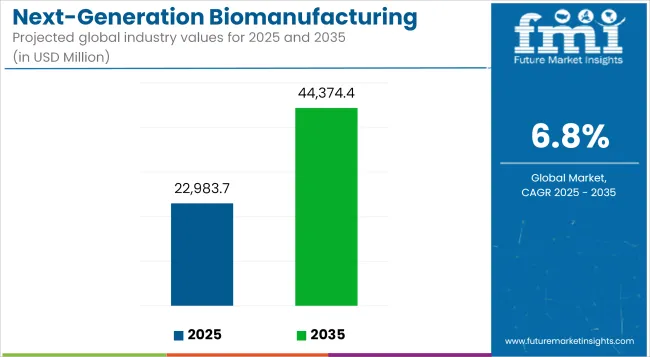
| Metric | Value |
|---|---|
| Market Size in 2025 | USD 22,983.68 Million |
| Projected Market Size in 2035 | USD 44,374.35 Million |
| CAGR (2025 to 2035) | 6.8% |
Biotechnologies are mature and very advanced in North American bio-pharma, and research facilities are very modern. North America is another leader in next-generation biomanufacturing. In particular, the United States is an overwhelmingly dominant force, with major participants developing its most up to date techniques for biomanufacturing.
At present the European Medicines Agency (EMA) is actively supporting the phase-out of old procedures and adoption of new cutting-edge techniques in biomanufacturing. This is also promoting market development.
The Next-Generation Biomanufacturing Market in Asia-Pacific is expanding. It is due to the increased far-sighted government investment in biotechnology and resultant growth of bio-pharma and rising demand for biosimilar.
Facilities for large-scale biopharmaceutical production have been built in China, India, South Korea and Japan, with extensive new technologies being introduced there at every opportunity. The region's fast market expansion is fuelled moreover by increased basic research capabilities and friendly policies towards innovation in bio-pharmaceuticals.
High Initial Investment Costs
To implement the next generation of biomanufacturing technologies likewise biggest capital input is required. High initial investment costs mean companies face challenges in adopting advanced bioprocessing methods.
Regulatory Complexities
Biomanufacturing is a highly regulated industry, and for biopharmaceutical production in particular there are strict guidelines. Manufacturers, especially smaller players operating on limited budgets, have to make sure that increasingly global regulation standards are met.
Advancements in Bioprocessing Technologies
Single-use bioreactors, continuous manufacturing, and cell-free synthesis are all making life much easier and faster in biomanufacturing. This creativity enables reductions in costs and greater flexibility of production.
Growing Demand for Biologics and Personalized Medicine
The widespread acceptance of biologics, biosimilar and individualized medicine is driving the market for next-generation biomanufacturing solutions. Developments in gene therapy, cell therapy, and vaccine production are producing substantial growth.
Between 2020 and 2024, the market shift resembled growth from traditional batch processing to scalable next generation bioprocessing methods. An uptake in automation and digital twin technology improved productivity, while systems of regulation reorganized themselves to licit new treatments and means heroic than ever before.
From 2025 to 2035, the market will see AI-driven biomanufacturing become all-pervasive, 3D bio printing will enter the mainstream and continuous-flow tank. Strategic collaboration among biotech companies, research institutions and regulatory agencies will push the boundaries of both production efficiency and therapeutic invention.
Market Shifts: A Comparative Analysis 2020 to 2024 vs. 2025 to 2035
| Market Shift | 2020 to 2024 Trends |
|---|---|
| Regulatory Landscape | Adaptation to new biologics manufacturing standards |
| Market Demand | Rising interest in biosimilars and gene therapies |
| Industry Adoption | Early adoption of automation and data analytics |
| Supply Chain and Sourcing | Shift toward single-use and modular bioprocessing |
| Market Competition | Dominated by established biopharma firms |
| Market Growth Drivers | Expansion of monoclonal antibody production |
| Sustainability and Energy Efficiency | Gradual shift to greener bioprocesses |
| Integration of Digital Innovations | Adoption of cloud-based data management |
| Advancements in Product Design | Improvements in bioreactor efficiency |
| Market Shift | 2025 to 2035 Projections |
|---|---|
| Regulatory Landscape | Streamlined frameworks supporting advanced therapies |
| Market Demand | Surge in personalized medicine and novel biopharmaceuticals |
| Industry Adoption | AI-powered biomanufacturing and process optimization |
| Supply Chain and Sourcing | Fully integrated smart biomanufacturing facilities |
| Market Competition | Increased competition from startups and contract manufacturers |
| Market Growth Drivers | Growth in regenerative medicine and synthetic biology |
| Sustainability and Energy Efficiency | Widespread adoption of sustainable and carbon-neutral manufacturing |
| Integration of Digital Innovations | AI, IoT, and digital twin technologies for biomanufacturing |
| Advancements in Product Design | Innovations in 3D bioprinting and next-gen therapeutic platforms |
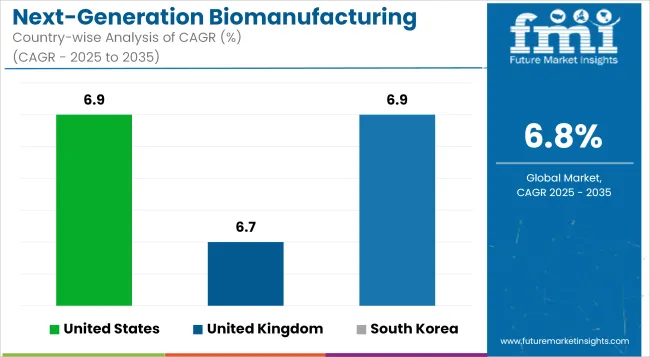
In the United States, where Next-Generation Biomanufacturing offers ample room for growth and expansion, it is medical research that is providing a stimulus to grow with frequent breakthroughs and development in biotechnology as well pharmaceuticals. More and more manufacturers have been getting involved in this field largest part of their own but there are still others engaged in cross-industry activities such as building process lines.
| Country | CAGR (2025 to 2035) |
|---|---|
| United States | 6.9% |
The UK Next-Generation Biomanufacturing Market is expanding in scope as companies adopt more sophisticated production methods. Several big automation vendors have begun to enter the vaccine field and are now complementing their med-to-upper applications by producing human vaccines.
| Country | CAGR (2025 to 2035) |
|---|---|
| United Kingdom | 6.7% |
The European Union’s next-generation biomanufacturing market is taking off. Stringent regulatory environments for sustainable development prompt the company to move from one development stage to the next.
| Region | CAGR (2025 to 2035) |
|---|---|
| European Union | 6.8% |
South Korea's Next-Generation Biomanufacturing Market is flourishing with advances in biotechnology and pharmaceuticals, thanks in part to outstanding medical technology research infrastructure and government incentive programs.
| Country | CAGR (2025 to 2035) |
|---|---|
| South Korea | 6.9% |
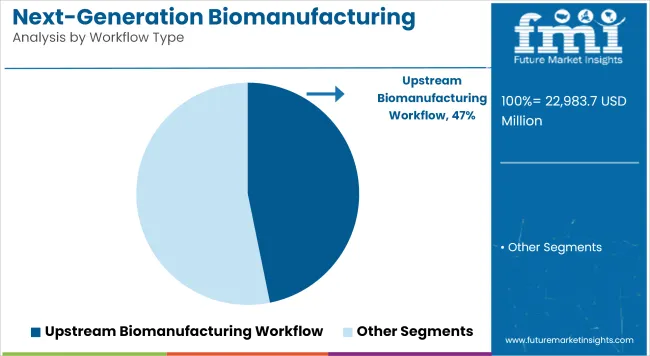
| Workflow Type | Market Share (2025) |
|---|---|
| Upstream Biomanufacturing Workflow | 46.8% |
By 2025 the upstream biomanufacturing workflow segment will account for 46.8% of the total market, a growth due to increased use of automated cell culture technologies, advanced bioreactors and genetically optimized cell lines.
Against this background, thus this workflow has become a vital link in cell growth, fermentation production and initial protein expression--it is a key step in the production of biopharmaceuticals. This type of workflow is vital in the production of cell mass and fermentation cultures, making it a key link in upstream biopharmaceutical manufacturing.
Advances in early-stage drug development and optimization science have further accelerated the upstream workflow, bringing us delicious new treats such as higher yield potential, reduced contamination risks and lower operating costs. As personalized medicine and biosimilar demand increase, manufacturers are investing more in next-generation upstream biomanufacturing solutions to improve efficiency and compliance with regulatory requirements.
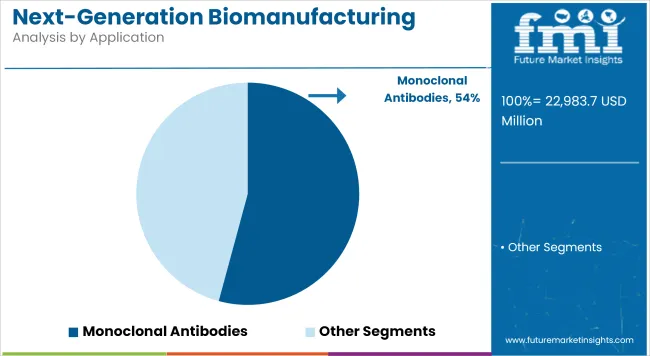
| Application | Market Share (2025) |
|---|---|
| Monoclonal Antibodies | 54.2% |
Next-generation biomanufacturing can be used in a variety of ways, and by 2025 the monoclonal antibodies (mAbs) segment will account for 54.2% of all new systems sales. This predominance is driven by growing levels of chronic diseases like diabetes and cancer, the use of targeted therapies instead surgery and improvements in antibody engineering technologies.
Monoclonal antibodies are now part of modern immunotherapies, with applications in disease research for infectious diseases, treatment for cancers like leukaemia and lymphomas all exerting great influence on their development. With the increased emphasis on biosimilars, antibody-drug conjugates (ADCs) and personalized biologics, next-generation biomanufacture techniques offer the bio manufacturer revolutionary control over antibody yield, purity and therapeutic effects.
By combining high-throughput screening, AI-guided bioprocess optimization and modular continuous production systems, researchers have transformed MAb manufacture into a single process that can roll off assembly lines in just six days at a cost of pennies per gram. The number of new drugs based on antibodies approved by regulators is increasing all the time, this fact serves to reinforce the position held by this latest segment in the market for antibody products.
As biopharmaceutical companies and contract manufacturing organizations (CMOs) sink money into cutting-edge next-generation biomanufacturing facilities, demand for next-generation monoclonal antibody production workflows will also rise. Therefore the monoclonal antibody segment will continue to hold fast in terms of both market share and scale, not only in terms of volume but also quality.
Advances in bioprocessing technology, automation, and AI-powered production systems are driving rapid growth in the next-generation biomanufacturing market. With continuous production, single-use bioreactors and cell-free synthesis gaining ground, biologics manufacturers have improved their mass and economical scales, as well as the control over their production processes.
Major companies are inventing new biomanufacturing methods so they can produce greater quantities at better prices as well as satisfy our hunger for customized medicines and biosimilars.
Market Share Analysis by Company
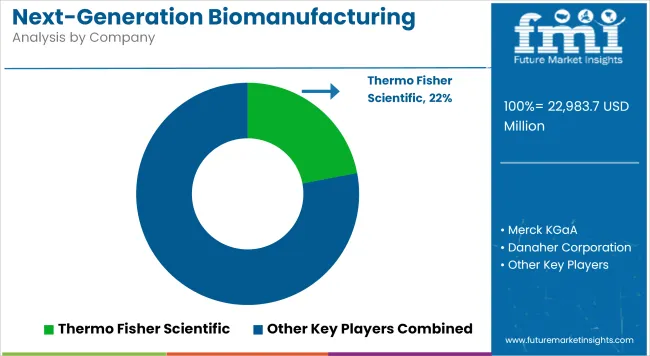
| Company Name | Estimated Market Share (%) |
|---|---|
| Thermo Fisher Scientific | 18-22% |
| Merck KGaA | 15-19% |
| Danaher Corporation | 12-16% |
| Sartorius AG | 10-14% |
| GE Healthcare | 8-12% |
| Other Companies (combined) | 30-40% |
| Company Name | Key Offerings/Activities |
|---|---|
| Thermo Fisher Scientific | In March 2024, launched an advanced single-use bioreactor system with enhanced automation. In January 2025, expanded its biomanufacturing facilities to support large-scale biologics production. |
| Merck KGaA | In April 2024, introduced AI-powered process analytics for optimized biologic production. In February 2025, announced strategic partnerships for mRNA biomanufacturing expansion. |
| Danaher Corporation | In May 2024, unveiled a next-generation chromatography system for high-purity biologics. In March 2025, acquired a biotech startup specializing in continuous bioprocessing. |
| Sartorius AG | In June 2024, developed a modular biomanufacturing platform for flexible production. In February 2025, partnered with pharmaceutical companies to enhance biosimilar production. |
| GE Healthcare | In August 2024, launched a scalable cell culture platform for precision medicine. In March 2025, expanded its portfolio with AI-integrated bioprocessing solutions. |
Key Company Insights
Thermo Fisher Scientific (18-22%)
Thermo Fisher leads the next-generation biomanufacturing sector with cutting-edge single-use technologies, AI-driven automation, and large-scale production capabilities.
Merck KGaA (15-19%)
Merck is investing in AI-driven process analytics and strategic partnerships to advance mRNA-based biomanufacturing and continuous production methods.
Danaher Corporation (12-16%)
Danaher focuses on innovative purification technologies and continuous bioprocessing solutions, driving efficiency and scalability in biomanufacturing.
Sartorius AG (10-14%)
Sartorius is developing modular and flexible biomanufacturing platforms that cater to biosimilar and personalized medicine production.
GE Healthcare (8-12%)
GE Healthcare is at the forefront of precision medicine biomanufacturing, leveraging AI and scalable cell culture platforms for biologics production.
Other Key Players (30-40% Combined)
The overall market size for Next-Generation Biomanufacturing market was USD 22,983.68 Million in 2025.
The Next-Generation Biomanufacturing market is expected to reach USD 44,374.35 Million in 2035.
The demand for next-generation biomanufacturing will be driven by advancements in single-use technologies, increasing biologics production, growing vaccine demand, rising monoclonal antibody usage, and improved efficiency in upstream and downstream biomanufacturing workflows.
The top 5 countries which drives the development of Next-Generation Biomanufacturing market are USA, European Union, Japan, South Korea and UK.
Upstream Biomanufacturing Workflow demand supplier to command significant share over the assessment period.






Our Research Products

The "Full Research Suite" delivers actionable market intel, deep dives on markets or technologies, so clients act faster, cut risk, and unlock growth.

The Leaderboard benchmarks and ranks top vendors, classifying them as Established Leaders, Leading Challengers, or Disruptors & Challengers.

Locates where complements amplify value and substitutes erode it, forecasting net impact by horizon

We deliver granular, decision-grade intel: market sizing, 5-year forecasts, pricing, adoption, usage, revenue, and operational KPIs—plus competitor tracking, regulation, and value chains—across 60 countries broadly.

Spot the shifts before they hit your P&L. We track inflection points, adoption curves, pricing moves, and ecosystem plays to show where demand is heading, why it is changing, and what to do next across high-growth markets and disruptive tech

Real-time reads of user behavior. We track shifting priorities, perceptions of today’s and next-gen services, and provider experience, then pace how fast tech moves from trial to adoption, blending buyer, consumer, and channel inputs with social signals (#WhySwitch, #UX).

Partner with our analyst team to build a custom report designed around your business priorities. From analysing market trends to assessing competitors or crafting bespoke datasets, we tailor insights to your needs.
Supplier Intelligence
Discovery & Profiling
Capacity & Footprint
Performance & Risk
Compliance & Governance
Commercial Readiness
Who Supplies Whom
Scorecards & Shortlists
Playbooks & Docs
Category Intelligence
Definition & Scope
Demand & Use Cases
Cost Drivers
Market Structure
Supply Chain Map
Trade & Policy
Operating Norms
Deliverables
Buyer Intelligence
Account Basics
Spend & Scope
Procurement Model
Vendor Requirements
Terms & Policies
Entry Strategy
Pain Points & Triggers
Outputs
Pricing Analysis
Benchmarks
Trends
Should-Cost
Indexation
Landed Cost
Commercial Terms
Deliverables
Brand Analysis
Positioning & Value Prop
Share & Presence
Customer Evidence
Go-to-Market
Digital & Reputation
Compliance & Trust
KPIs & Gaps
Outputs
Full Research Suite comprises of:
Market outlook & trends analysis
Interviews & case studies
Strategic recommendations
Vendor profiles & capabilities analysis
5-year forecasts
8 regions and 60+ country-level data splits
Market segment data splits
12 months of continuous data updates
DELIVERED AS:
PDF EXCEL ONLINE

Thank you!
You will receive an email from our Business Development Manager. Please be sure to check your SPAM/JUNK folder too.
Chat With
MaRIA